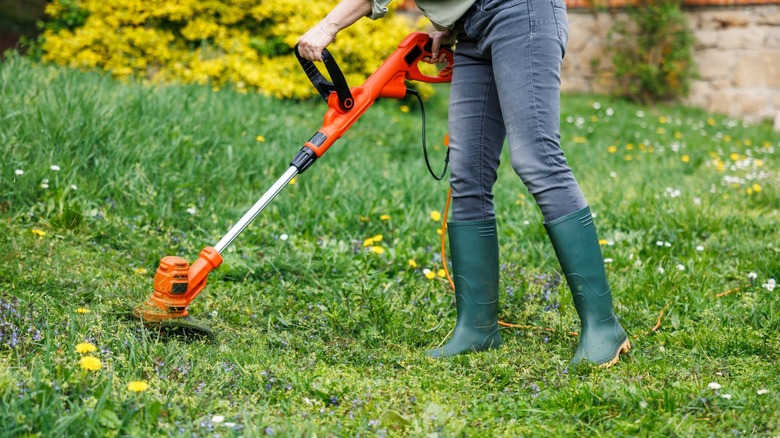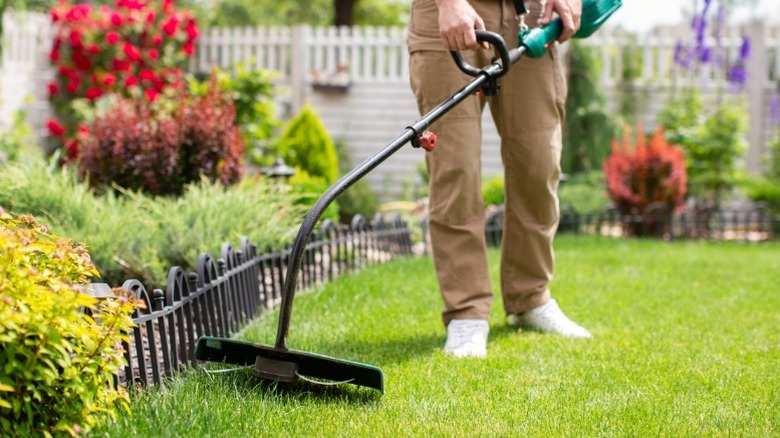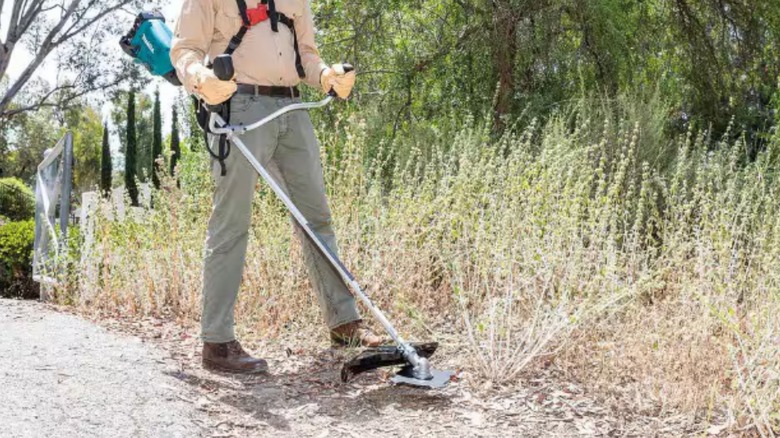String Trimmer Vs. Brush Cutter: What's The Difference?
If you're a homeowner or have ever worked in the landscaping industry, you probably know that there are many different types of lawn and garden tools designed to make chores like cutting the grass less strenuous. These instruments include everything from walk-behind and riding lawn mowers to weed eaters, leaf blowers, hedge trimmers, and much more. But while many people recognize and even use these tools regularly, the differences between some of these devices aren't always clear. That's especially true for tools that look similar to one another, like hedge trimmers and chainsaws or string trimmers and brush cutters.
In the case of string trimmers vs. brush cutters, the differences lie largely in the instruments' intended applications. Both string trimmers and brush cutters tend to have similar appearances. They're usually long poles with an engine or motor at one end and a cutting head at the opposite end. However, if you look closely, you'll notice that, as the name implies, string trimmers use a special type of plastic thread or string, while brush cutters usually have metal blades or cutting disks. That's because, as mentioned, these tools are designed for different landscaping purposes. While string trimmers are ideal for clearing away light overgrowth and cleaning up the edges of your lawn, brush cutters are better-suited for heavy-duty work, like mowing down thick vegetation. If you're interested in a more in-depth explanation of the differences between these two tools, you're in luck. Here's everything you need to know about string trimmers vs. brush cutters.
What is a string trimmer?
String trimmers — also known as weed eaters — are lawn and garden tools designed to cut light to medium-thickness vegetation. As the name implies, these devices rely on a special type of plastic string and, usually, either an electric motor or a gas-powered engine. The engine or motor generates power and rotates a cutting head. Depending on the type of string trimmer, you must install the plastic string by inserting a spool into the cutting head and feeding the ends of the line through holes on either side. Then, as the cutting head spins, the plastic string rotates rapidly, slicing through any vegetation or weeds in its path.
These tools are ideal for performing tasks like edging a lawn, trimming around garden fixtures and plants, and clearing out light overgrowth. They're commonly used by everyone from homeowners to professional landscapers and are available in various sizes, fuel types, and power levels. Depending on the model, some string trimmers even allow you to swap out cutting heads, enabling you to use one tool as both a weed eater and a brush cutter. Other features you may frequently find on a string trimmer include automatic bump feed mechanisms, which enable you to let out more string by bumping the cutting head against the ground, and the ability to rotate the cutting head to make tasks like edging a lawn easier.
What is a brush cutter?
Like string trimmers, brush cutters are lawn and garden tools designed to clear out various forms of vegetation and overgrowth. The difference is that brush cutters can be thought of as the bigger, beefier sibling of standard weed eaters. These tools are able to handle much thicker vegetation, including things like saplings and thick vines. Similar to string trimmers, brush cutters usually feature an electric motor or a gas-powered engine and a cutting head. However, a brush cutter's motor or engine may be substantially more powerful than a string trimmer's, and its cutting head will usually feature metal blades or cutting disks instead of plastic string.
Brush cutters are ideal for heavy-duty work, like clearing overgrowth from an empty lot or trimming back the wood line behind your house. They're less commonly used for everyday yard work and see more use in rural and professional settings. As mentioned, some string trimmers and brush cutters offer the ability to perform both types of tasks with a single tool. In these cases, you may simply have to swap the cutting head out in order to tackle a different job. If you're in the market for a string trimmer or a brush cutter and are unsure of which to buy, you may want to consider a model that offers both cutting styles. However, if you live in a relatively normal residential area with little overgrowth, you'll probably be fine with a regular weed eater.


